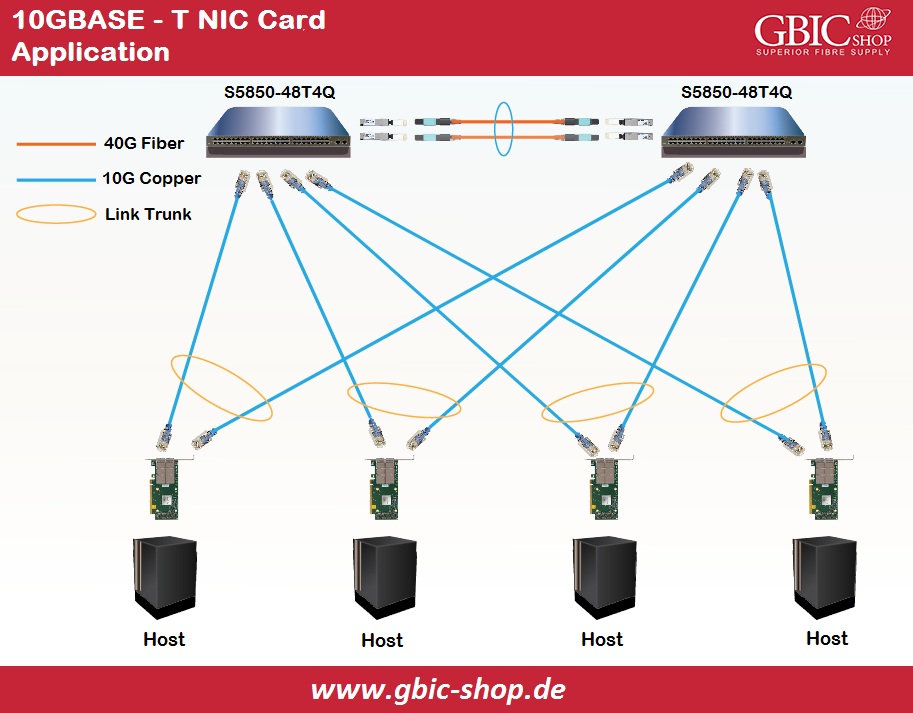NIC (Network Interface Card), which supports the network connection, is essential for any network. Especially for users of data centers or companies, the use of NIC is diverse. There are NIC cards with different data rates, port numbers or even different communication media. Do you know which type of NIC card we can use under which circumstances?
Why should we consider using a network card?
The use of NICs is closely related to the function of the network card. Physically, a NIC, regardless of whether it is an add-in card or an integrated card, can form the hardware interface between a network and network devices. It makes no difference whether the NIC network is wireless or wired; we can provide the network communication. In addition, by using NIC cards, we can realize communication between terminal devices connected via LAN (Local Area Network) and communication over an extensive network via IP (Internet Protocol). NIC provides a hardware circuit to realize the data link and the physical layers as one device in both the data link and the physical layers.
How can we use a 10Gb/25Gb/40Gb network interface card?
NIC solutions differ in different network conditions. In this section, 10 Gigabit Ethernet, 25 Gigabit Ethernet and 40 GbE NICs are discussed to analyze their network implementations.
Implementation of a 10GBASE-T network interface card:
10GBASE-T is a primary 10 Gigabit copper network card. We have 10GBASE-T switches connected to four hosts via separate 10 Gigabit copper links. We have formed dual 40 Gigabit links between two switches to understand Multi-Chassis Link Aggregation Group (MLAG) to increase network reliability and bandwidth. This topology requires a dual-port 10 Gigabit NIC for each host to provide two 10 Gigabit connections. Analyzing the connection via fiber optic cable and transceiver, 10GB copper NIC together with network cables is a cost-effective solution. However, this connection is only suitable for devices that can support 10GBASE-T, and the communication range is no more than 100 meters.

The product catalog for this 10GBASE-T network interface card implementation can be found in the following table:
%20in%2010%20gigabit25%20gigabit40%20gigabit%20server%20to%20switch%20links%20(2).jpg)
10 Gigabit SFP+ NIC card implementation:
Just like the 10 Gigabit copper network described above, we have two stackable switches to increase network flexibility and facilitate network management in this data link layer network. With 24 Small Form Factor Pluggable+ ports, the two switches can support 10 Gigabit fiber downlinks to each host. We need four 10 Gigabit fiber network interface cards in this host-to-switch situation. Users can select 10 Gigabit quad-port or dual-port network interface cards as needed. For 10 Gigabit network interface cards with four ports, we can use two free slots for each network interface card for future expansion or redundancy. The standard solution of SFP+ NIC, SFP+ optical transceivers and fiber optic cables for host-to-switch connections is suitable for long distance transmission. And for short distance communication within 10 meters, the SFP+ NIC with 10 Gigabit DAC cables are more cost-effective for users.
%20in%2010%20gigabit25%20gigabit40%20gigabit%20server%20to%20switch%20links%20(3).jpg)
The product catalog for this 10 Gigabit host switch connection is listed in the following table:
%20in%2010%20gigabit25%20gigabit40%20gigabit%20server%20to%20switch%20links%20(4).jpg)
25 Gigabit NIC card implementation:
In this network interface card system, we have two 25-gigabit data center switches that have a connection with four servers. As in the above implementation of 10 Gigabit NIC card, we can understand each 25 Gigabit connection between server and switch in two ways. We can use 25 Gigabit NIC, SFP28 and optical patch cable for long distance transmission. And for short distance communication within 5 meters, we can use 25 Gigabit NIC and small form factor pluggable 28 DAC cables.
%20in%2010%20gigabit25%20gigabit40%20gigabit%20server%20to%20switch%20links%20(5).jpg)
The product catalog for this 25 Gigabit server-to-switch connection can be found in the table below:
%20in%2010%20gigabit25%20gigabit40%20gigabit%20server%20to%20switch%20links%20(6).jpg)
40 Gigabit Ethernet NIC card implementation:
In this 40-gigabit spine leaf network, we have implemented two 40-gigabyte spine switches with MLAG; both are connected to a 40-gigabit switch within the leaf layer. The leaf switch, on the other hand, has a connection to a server for 40 Gigabit transmission. We should use 40 Gigabit Ethernet NICs to realize 40 Gigabit transmission between a server and a leaf switch. We can use a 40 Gigabit QSFP+ optical transceiver and fiber optic cable together with a 40 Gigabit Ethernet NIC for long-distance 40 Gigabit transmission. In addition, we can realize short-distance transmission within 7 m with a 40 GbE network interface card and a QSFP+ DAC cable.
%20in%2010%20gigabit25%20gigabit40%20gigabit%20server%20to%20switch%20links%20(7).jpg)
The product catalog for this 40 Gigabit server-to-switch connection can be found in the table below.
%20in%2010%20gigabit25%20gigabit40%20gigabit%20server%20to%20switch%20links%20(8).jpg)
Conclusion:
Depending on the customer's network conditions and needs, the use of NICs is flexible. Depending on the communication medium of the connection, we can use an optical or a copper NIC. We can choose multi-port or single-port NICs to meet the number of connections and future expansion and network redundancy requirements. We can also use network interface cards with different data rates for different bandwidth requirements. GBIC can present better NIC network schemes and an extensive range of 10 Gigabit Ethernet/25 Gigabit Ethernet/40 Gigabit Ethernet NIC solutions with different transmission media and functions, port counts and data rates for your choice.
 English
English
 Deutsch
Deutsch
 Espaniol
Espaniol










